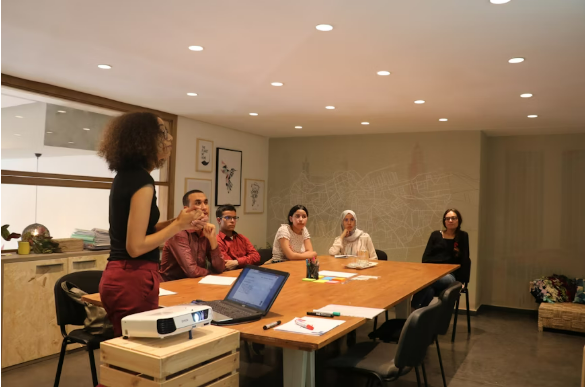From Reactive to Proactive: How Agentic AI Revolutionizes Workday Headcount Management and Workforce Planning
Three weeks into Q3, and your headcount data still doesn't align across systems. Finance sees one set of numbers in their planning tools, HR has different data in Workday, and Recruiting is working from yet another version in their ATS. This common Workday headcount management mistake isn't a technology failure—it's the reality of managing complex workforce data across multiple platforms.
Workday recognizes this challenge and has been actively building toward the future. Their September 2024 launch of Workday Illuminate demonstrated their commitment to AI-powered insights, followed by the February 2025 release of Agent System of Record through the Workday Marketplace. These developments signal Workday's understanding that the future of workforce management lies in intelligent, autonomous systems that can bridge data gaps and provide proactive insights.
As our CEO, Seena Mojahedi, put it, “We're at an inflection point where the traditional 'wait and see' approach to workforce technology is actually becoming the riskier strategy. Agentic AI isn't just another tool in the headcount management toolkit—it's fundamentally rewiring how organizations think about workforce intelligence. The question isn't whether to adopt agentic AI—it's whether you want to lead this transformation or be forced to catch up when your talent acquisition speed and budget accuracy can't compete with organizations that made this move early.”
Yes, agentic AI workforce management represents the next evolution—moving beyond traditional automation to systems that don't just process data, but actively monitor, analyze, recommend, and take actions to optimize your workforce strategy. It’s the future, it’s here now, and we need to understand how it works and utilize it to the full to stay ahead and thrive.
Understanding Agentic AI: Beyond the Buzzwords
When you compare traditional and agentic AI, the key distinction is autonomy and initiative. Traditional AI and automation in headcount management software operate on predefined rules—they automate tasks like routing requisitions for approval or generating scheduled reports when triggered.
Agentic AI functions more like a strategic partner. It understands your workforce objectives, continuously monitors real-time data across systems, and takes initiative to keep your organization aligned with those goals. Think of it as the difference between a workflow engine and a collaborative advisor.
Comparing Traditional Workday Automation vs. Agentic AI: A Real-Life Example
Let’s say your Finance team needs to update Q3 headcount forecasts mid-quarter. They want to check how hiring is pacing vs. plan, flag risks to budget or delivery, and recommend adjustments (e.g., slow hiring in low-priority orgs).
The traditional approach requires 13-19 hours (a minimum of 2-3 business days) across Finance, Recruiting, and HR teams to extract data from various systems, analyze hiring pipelines, identify risks, and develop recommendations.
With agentic AI, this same analysis completes in approximately 15-20 minutes. The system autonomously:
Accesses current data from Workday
Evaluates hiring pipeline status across recruiting systems
Reconciles against financial plans
Calculates projected impacts
Generates specific recommendations such as strategic hiring adjustments or budget reallocations.
Executes those recommendations within defined parameters
Instead of 3 teams spending 2 days pulling and reconciling stale data, Agentic AI flags headcount risks in real time, tells you where to reallocate budget, and gives you the summary slide. It’s like adding a full-time workforce analyst to the team—without the headcount.
This transforms workforce planning from periodic reporting exercises into continuous strategic optimization. You go from "help me complete this process" to "help me achieve this outcome."
Rather than simply flagging issues in dashboards, agentic AI provides actionable intelligence that enables faster, more informed decision-making. This represents a shift toward true workforce intelligence—systems that don't just report on workforce data, but actively contribute to workforce strategy.
3 Transformative Use Cases for Agentic AI in Workday Headcount Management (400 words)
While the potential applications of agentic AI are vast, we’ve really narrowed down three specific use cases that stand out for their immediate impact and clear ROI in Workday environments. These are practical solutions to the daily frustrations that consume hours of your team's time and create ongoing friction between departments.
1. Intelligent Requisition Management and Strategic Alignment
Current challenge: Workday displays open positions without context about their continued relevance, strategic alignment, or relationship to evolving business priorities. This leads to resource allocation inefficiencies and misaligned hiring efforts.
Agentic AI continuously evaluates:
Organizational structure
Performance metrics
Attrition patterns
Strategic objectives
It identifies open requisitions that may be outdated or redundant and recommends reallocation based on current business needs. Rather than managing static job requisition lists, organizations gain dynamic workforce planning that adapts to changing priorities in real-time.
2. Automated Cross-System Reconciliation and Budget Optimization
The current process of aligning approved headcount, actual hires, and budget allocations across Workday, planning systems, and recruiting platforms typically requires significant manual effort each quarter. This creates delays in decision-making and reduces visibility into budget performance. It also costs tens of thousands of dollars per year in time, manpower, and capital.
An agentic AI system functions as a continuous reconciliation engine by monitoring data flows between HRIS, financial planning tools, and recruiting systems. It provides early alerts when trends indicate potential budget variances and suggests specific corrective actions such as adjusting hiring timelines, consolidating similar roles, or reallocating approved headcount to higher-priority areas.
3. Predictive Workforce Analytics and Strategic Forecasting
Traditional Workday dashboards often act like rearview mirrors—they tell you what has already happened, not what’s coming next. This makes it difficult to spot early warning signs, such as when hiring is drifting off target, attrition is poised to disrupt forecasts, or your talent plan is slowly misaligning with business strategy. By the time these risks surface in static reports, it’s often too late to course-correct without disruption or cost overruns.
Agentic AI changes this dynamic by serving as a forward-looking radar for workforce planning. It continuously:
Monitors key indicators like hiring velocity, time-to-fill, organizational spans and layers, and churn risk in real time.
Generates proactive “talent risk alerts” when patterns emerge that could jeopardize your plan (e.g., “Your GTM headcount plan is slipping behind ARR growth”)
Runs impact simulations to forecast downstream effects (for example, how delaying five critical hires could reduce pipeline coverage by 12% in Q3)
The result is a shift from reactive reporting to true strategic foresight. Instead of iThe result is a shift from reactive reporting to true strategic foresight. Instead of identifying problems after they’ve already hurt performance, you gain the ability to anticipate risks, evaluate scenarios, and take timely action to keep your workforce strategy—and your financial targets—on track.
The Cross-Functional Impact: Why This Matters for Every Stakeholder
The real power of agentic AI isn't just in solving individual departmental challenges—it's in transforming how Finance, HR, and Recruiting collaborate around shared workforce objectives. When intelligent systems provide a unified foundation of real-time data and insights, the traditional silos and conflicts around headcount planning begin to dissolve.
HR
HR teams can shift focus from manual data reconciliation and system maintenance to strategic workforce development. The AI handles routine monitoring and exception identification so HR professionals can concentrate on organizational design, talent strategy, and employee experience initiatives.
Finance
Finance teams gain enhanced visibility into hiring velocity, pipeline timing, and budget implications without depending on manual reporting cycles. Predictive analytics and scenario modeling enable proactive financial planning rather than reactive adjustments when quarterly results reveal variances.
Recruiting
Recruiting teams benefit from automated prioritization of critical roles, real-time budget validation, and elimination of efforts on obsolete positions. The AI ensures recruiting activities align with current strategic priorities while providing pipeline insights that improve forecasting accuracy.
Cross-Functional Collaboration
The traditional tension between HR, Finance, and Recruiting often stems from operating with different data sources, timelines, and success metrics. Agentic AI creates a foundation for improved collaboration by ensuring all stakeholders work from consistent, real-time information.
Cross-functional effectiveness improves significantly when teams operate from the same real-time data foundation. Strategic discussions can focus on workforce optimization and business alignment rather than reconciling conflicting reports and defending data sources.
What Leaders Need to Know About AI and Humans in Headcount Management
The most common misconception among leaders is viewing AI implementation as a human replacement strategy rather than a capability enhancement approach. Effective agentic AI workforce management amplifies human expertise by handling:
Data processing
Pattern recognition
Routine monitoring
That way, professionals can focus on strategic analysis and decision-making.
Successful implementations establish clear governance frameworks where AI operates within defined parameters and escalation protocols. The system might recommend hiring adjustments based on budget trends, but strategic decisions continue to require human judgment and contextual understanding that experienced leaders provide.
The Evolution Toward Conversational Workforce Planning
The most exciting development ahead is AI systems that function as true strategic partners in workforce planning. Imagine querying your system with questions like "What's the optimal timing for our Q4 product team expansion given current pipeline velocity and budget constraints?" and receiving comprehensive strategic recommendations rather than raw data.
We’re working towards building these agentic AI functionalities into our comprehensive headcount management software Kinnect to that companies can enjoy even more streamlined, automated Workday headcount management, saving tens and even hundreds of thousands of dollars and hundreds of hours each year.
This conversational approach to workforce intelligence transforms headcount management from reactive reporting to proactive strategy development. Leaders gain natural language insights that support confident decision-making within real business contexts, moving beyond dashboard analysis to strategic partnership with intelligent systems.
You Can Stay Ahead of the Agentic AI Revolution in Workforce Planning
The transformation from traditional headcount management to intelligent workforce planning isn't just coming—it's here. Organizations that embrace agentic AI now will gain significant competitive advantages in talent acquisition, budget management, and strategic agility.
Success requires more than technology implementation; it demands rethinking how Finance, HR, and Recruiting collaborate around shared workforce goals. The winners will be organizations that view AI as a strategic enabler of human expertise, not a replacement for it.
Workday's recent AI developments demonstrate the platform's commitment to this intelligent future. As these capabilities mature and expand, organizations need partners who understand both the technical integration requirements and the strategic potential of agentic workforce management.
At Kinnect, we're building the future of intelligent headcount management that connects seamlessly with Workday while providing the agentic capabilities that transform headcount planning from an administrative burden to a strategic advantage that saves tens of thousands of dollars and hundreds of hours per year. Our platform combines deep Workday integration expertise with cutting-edge AI to deliver the real-time insights and proactive recommendations that modern organizations need.
Ready to explore how agentic AI could revolutionize your workforce planning strategy? Connect with our team today to discuss how intelligent Workday headcount management can transform your organization's approach to talent strategy and budget optimization.



